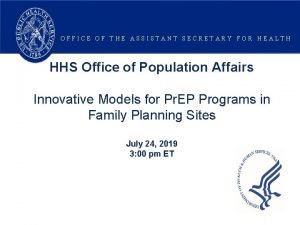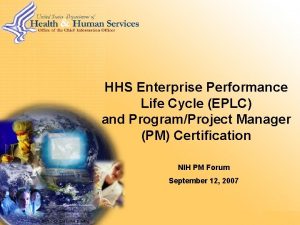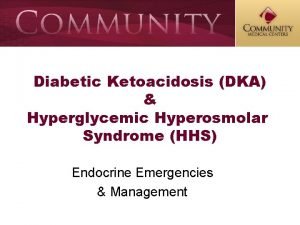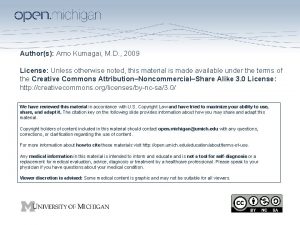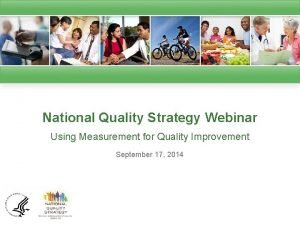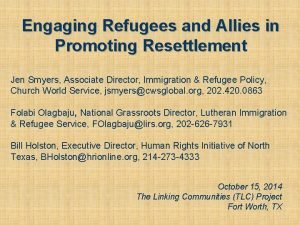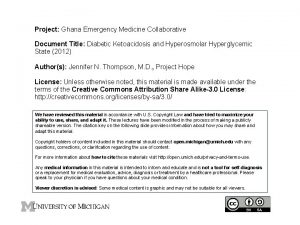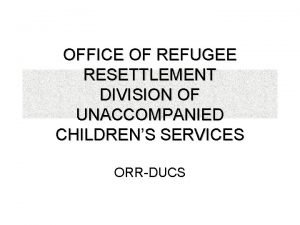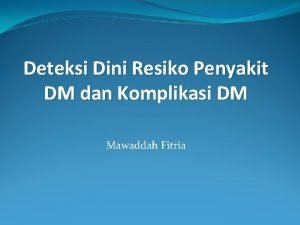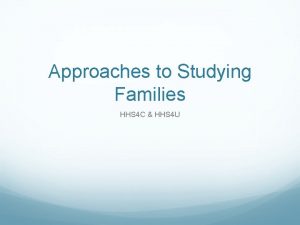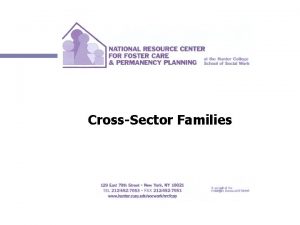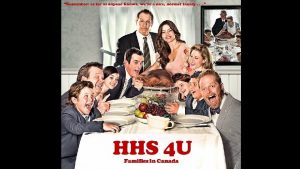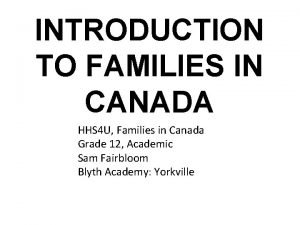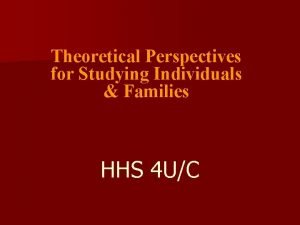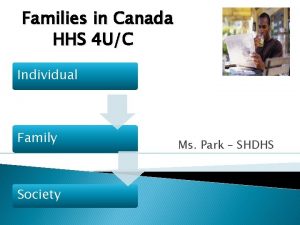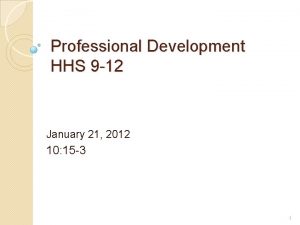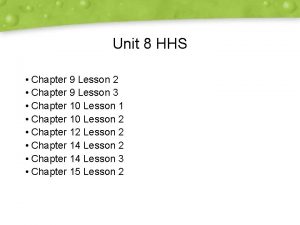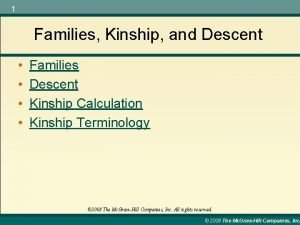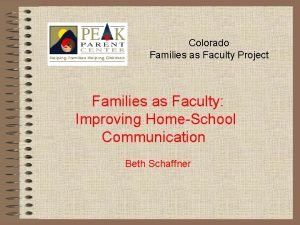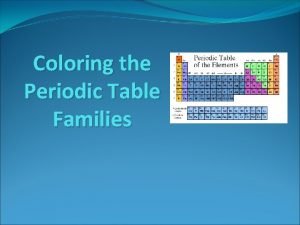THE DEVELOPMENT OF FAMILIES HHS 4 UC Unit






















- Slides: 22

THE DEVELOPMENT OF FAMILIES HHS 4 U/C Unit 4

Remember this? ? . . .

Remember this? ? … Why is it hard to define families? What definitions of “family” did we discuss? What were the differences?

The Vanier Institute definition: Any combination of two or more persons who are bound together over time by ties of mutual consent, birth and/or adoption or placement and who, together, assume responsibilities for variant combinations of some of the following: � Physical maintenance and care of group members � Addition of new members through procreation or adoption � Socialization of children � Social control of members � Production, consumption, distribution of goods and services

The Statistics Canada definition: “The census family refers to a husband a wife (with or without children who have never married regardless of age), couples living together (with or without children who have never married, from one or both partners) or a lone parent (with one or more children who have never married regardless of age) living in the same dwelling”

The United Nations definition: “…the family is referred to as the basic unit of society; it is appreciated for the important socioeconomic functions it performs. In spite of the many changes in society that have altered its role and functions, it continues to provide the natural framework for the emotional, financial and material support essential for the growth and development of its members, particularly infants and children, for the care of other dependents including the elderly, disabled, and infirm. The family remains a vital means of preserving and transmitting cultural values. In the broader sense, it can, and often does, educate, train, motivate and support its individual members, thereby investing in their future growth and acting as a vital resource for development”

Families as Agents of Socialization In the past… � The goal was to pass on the family name and traditions � Also, families were needed for labour Now… � The goal is to raise happy, well-adjusted children � Children are no longer valued economically but for their emotional fulfillment

Families of the Past… As a group, select one family: � Aboriginal (pgs 266 -268) � European (pgs 268 -269) � European … continued (pgs 270 -271) � European … continued (pgs 272 -273) � Chinese (pgs 273 -274) � Toda (pgs 274 -275) Summarize the trends into 5 points to share with the class

Families of the Present… Couples in the 21 st century who are considering having children have many more choices and face more complex issues than families of the past The institution of marriage has changed Social norms in regard to sex roles, conception, and the equality of women contribute to the decline in fertility rates Couples can choose when to have children, how many to have, and when they’d like to stop permanently due to advances in

Families of the Present… Childbearing is delayed due to education and career goals of women � The average of mothers at the birth of their first child in 2010 was 29. 6 years � 51% of all mothers who gave birth in 2010 were 30 or older

Source: Statistics Canada

Families of the Present… Women continue to work after marriage and childbirth � In 2008, 64% of husband-wife families were dualincome earners (up from 47% in 1976) Advances in reproductive technology now allows couples who are infertile to have children � Artifical insemination, in vitro fertilization, etc.

Families of the Present… Babies are healthier due to increased knowledge of prenatal care � Nutrition during pregnancy, dangers of smoking and drinking, etc. � Genetic testing enables couples to determine the risk of inherited problems and to choose whether to terminate an unhealthy pregnancy � The infant mortality rate has declined steadily over the past century

Families of the Present… There is a lack of support for parents � Families struggle to balance careers and children � Workplaces are often inflexible and have inadequate child-care programs

Theoretical Perspectives Describe the development of family and parent -child relationships from the viewpoint of the different theoretical perspectives For example …

Theoretical Perspectives Social Exchange theory � Couples look to receive something back from their children (a benefit) in exchange for their time, energy, and money they put into raising them (costs) These benefits include emotional fulfillment and love Systems Theory � The work pattern of women influences all members of the family (scheduling, homework completion, activities, meal preparation, shopping, etc. )

The Decision to have Children What factors influence decisions about having children? � Fertility and/or access to reproductive technology � Access to birth control � Religious or cultural beliefs (i. e. abortion) � Stability of the intimate relationship � Age and health � Financial status � Educational, career, and personal goals � Influence of friends/family

Legislation to Support Families Parental and maternity leave � Pregnancy leave – 17 weeks unpaid � Parental leave – 35 to 37 weeks unpaid � Can apply for EI benefits (pay from the government while you are off; sometimes “topped up” by employer) Protection against discrimination because of pregnancy � Continue to pay into and earn benefits while off � Maintain the same seniority and salary as when they left � In most cases, the job they leave is to be available when they come back � Cannot be penalized in away for taking parental

Legislation to Support Families The right to breastfeed in public � Charter of Rights and Freedoms Adoption rights for same-sex couples � Since 1999 same-sex couples have had the same rights to adopt as heterosexual couples � In 2011, 9% of couples with children were samesex � More female-female couples adopt than male

Same-Sex Families Raising Children

Legislation to Support Families Subsidized child care � The government helps eligible families pay for day care or before/after-school programs for children under 12 � Depends on family income

Challenges Faced by Families Family conflict Children or family members with special needs Child abuse and neglect � Discipline Elder abuse and neglect Spousal abuse Teen pregnancy Childlessness � By vs. Punishment choice, infertility, or death Divorce Immigration
 Little families
Little families Hhs office of population affairs
Hhs office of population affairs Enterprise performance life cycle
Enterprise performance life cycle Dka
Dka Hhs diabetes
Hhs diabetes What is aspr
What is aspr Dka and electrolytes
Dka and electrolytes Bibits
Bibits Hhs sbir sttr
Hhs sbir sttr Diabetic ketoacidosis
Diabetic ketoacidosis Hhs diabetes
Hhs diabetes Infant oral health care
Infant oral health care National quality strategy
National quality strategy Jen smyers hhs
Jen smyers hhs Tell and sell gesprek
Tell and sell gesprek Hhs vs dka
Hhs vs dka Richard zapata hhs
Richard zapata hhs Kad dan hhs
Kad dan hhs Todd simpson hhs
Todd simpson hhs Dka vs hhs
Dka vs hhs Shs+
Shs+ Unit 6 review questions
Unit 6 review questions Hình ảnh bộ gõ cơ thể búng tay
Hình ảnh bộ gõ cơ thể búng tay

